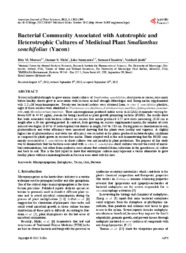Bacterial community associated with autotrophic and heterotrophic cultures of medicinal plant smallanthus sonchifolius (Yacon).
Bacterial community associated with autotrophic and heterotrophic cultures of medicinal plant smallanthus sonchifolius (Yacon).
Autoria: MORAES, R. M.; MELO, I. S. de; SUMYANTO, J.; CHANDRA, S.; JOSHI, V.
Resumo: Several unfruitful attempts to grow axenic shoot cultures of Smallanthus sonchifolius, also known as yacon, were made before healthy shoots grew in association with bacteria on half strength Murashigue and Skoog media supplemented with 2.2 µM benzylaminopurine. Twenty-one bacterial isolates were obtained from in vitro S. sonchifolius plantlets, eight of these isolates were identified as Flavimonas oryzihabitans, Curtobacterium pusillum, Sphingomonas paucimobilis, and Microbacterium imperiale. These microorganisms produced indole acetic acid (IAA) at amounts varying between 8.89 to 47.45 µg/mL, reason for being classified as plant growth promoting bacteria (PGPB). The results show that buds associated with bacteria cultured on sucrose free media produced 3.77 new roots measuring 18.33 cm in length after a 30-day growing period. In contrast, buds growing on sucrose supplemented media, the number of roots induced was higher (6.67 to 14 roots/explant) but shorter in length, 4.67 to 5.83 cm. During plant acclimatization to soil, photosynthesis and water efficiency were measured showing that the plants were healthy and vigorous. A slightly higher rate of photosynthesis and water use efficiency was recorded in the plants produced on heterotrophic conditions as compared to plants grown in sucrose free media. Plants adapted well in the soil demonstrating that the PGPB community associated to S. sonchifolius in shoot cultures was not harmful to plant production. The purpose of this study was to demonstrate that the bacteria associated with in vitro S. sonchifolius shoot cultures was not the result of microbial contamination, but rather from symbiotic associations that extended from cultivation in the greenhouse, to culture and back to soil. This is the first report to show that autotrophic cultures may represent a viable alternative to grow healthy plants without eliminating beneficial bacteria associated with the host.
Ano de publicação: 2012
Tipo de publicação: Artigo de periódico
Unidade: Embrapa Meio Ambiente
Palavras-chave: Bactéria, Endophytes, IAA, Indole acetic acid, Micropropagation, Planta medicinal, Smallanthus sonchifolius, Yacon, Çido indolacético
Observações
1 - Por padrão são exibidas publicações dos últimos 20 anos. Para encontrar publicações mais antigas, configure o filtro ano de publicação, colocando o ano a partir do qual você deseja encontrar publicações. O filtro está na coluna da esquerda na busca acima.
2 - Para ler algumas publicações da Embrapa (apenas as que estão em formato ePub), é necessário ter, no celular ou computador, um desses softwares gratuitos. Sistemas Android: Google Play Livros; IOS: iBooks; Windows e Linux: software Calibre.
Acesse outras publicações
Acesse a Base de Dados da Pesquisa Agropecuária (BDPA) para consultar o acervo completo das bibliotecas da Embrapa.

